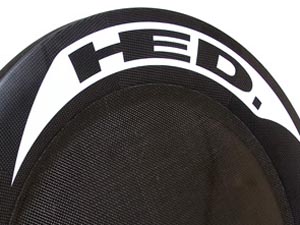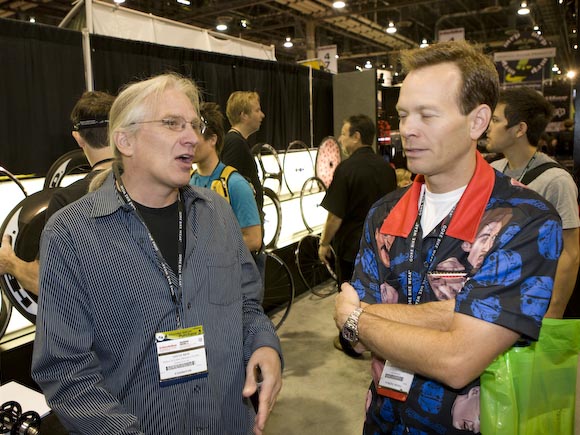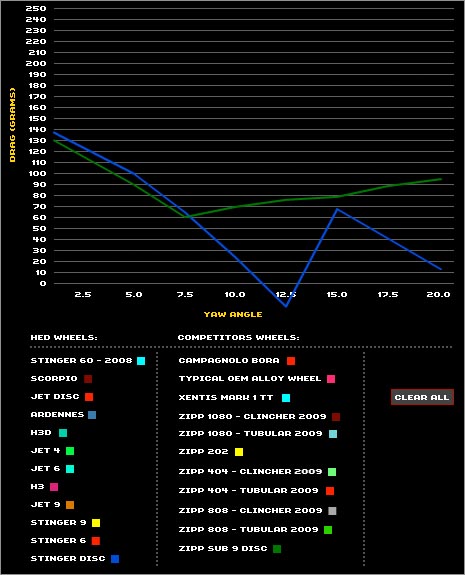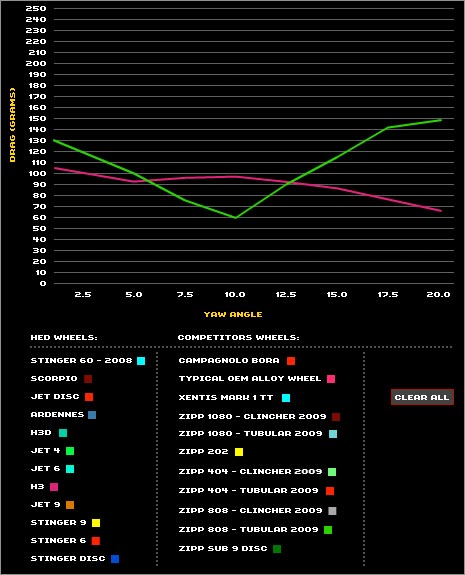
Zipp had issues with my Revolution Wheelworks review, and the subsequent Zipp article has now upset Steve Hed. I got an email from Hed stating that while he and Zipp have a cordial relationship and would like to continue to do so, he wanted to rebut some of the claims in the article.
Round 1
Regarding Poertner’s claim that Hed optimizes his wheels for a yaw angle of 26 degrees, Hed wrote:
We do not base our wheel designs on a 26 degree wind angle. It is true that our website points out that a slower rider (19mph) can see an angle of 26 in a 10mph sidewind. The preceding sentence on our website states that a 27mph rider in the same wind sees a 17 degree apparent wind, and it illustrates that at different speeds riders encounter different wind conditions. This is not a statement that we base our rim designs on 26 degrees.
As for this statement, "before Zipp introduced the 808 in 2004, neither company produced rims of this shape, and that before the 808 ventured to be 28mm wide, neither company was making super wide toroidal rims that are now the staple of both companies", Hed responded:
Our patent was granted in 1990, the same year we produced the toriodal shaped CX wheel. All our wire spoked wheels have used this toroidal shape continuously since then. The original CX had a 26mm wide rim section – certainly wide for the time, and still wide by current standards. The Jet 90 and CX Deep entered into production in 1996, nine years before the 808 was available.
And regarding this, "He also points out that over the last few years the Hed rim shapes and wind tunnel data have started to look an awful lot like Zipp rim shapes and Zipp data."
In the early 90s Zipp’s wheels were deep V shapes with flat sides and a rounded nose section. Our CX had a 21mm width at the rim bed, and bulged out to 26mm partway down the rim before narrowing to a rounded nose at the spoke bed. We were using wind tunnels in the late ’80s, and nothing has changed about the way air flows over a wheel since then. The fact is that since Zipp acquired our patent (sometime in the late 90s) their wheels have changed shape to more closely mirror the wheels we started selling 18 years ago. We have continually improved them since then, but the underlying aero shapes are still similar. As Zipp’s wheel shapes have changed to more closely resemble ours, it only follows that their wind tunnel data is more like ours too.

Round 2
I asked Hed what angle or range of angles does he optimize his wheels for?
The answer is that there is not a likely yaw angle, there is a percentage where one wheel is faster or slower, and a percentage where they are roughly equal. What we tried to convey (and what was misconstrued) on the website is that this percentage changes for different speed riders. Figuring the range of wind angles from straight headwind (zero degrees) to tailwind (170 degrees) the numbers for H3 vs Jet9 work out like this:
A 20mph rider in a 7 mph wind is faster on the H3 in 38% of possible wind angles
Faster on a Jet 9 in 26% of possible wind angles
Roughly the same in 36% of wind angles.
With this wind, in 3/4 of wind angles the H3 on a 20mph guy is better off or not hurt on the H3. In 1/4 of wind angles, the Jet 90 will be the faster wheel. Same conditions with a 27mph guy? 90 will be faster 53%, H3 will be faster 26%, and about the same is 21%. The argument that courses have turns and direction changes is quite valid. It makes it very likely that riders will "see" several wind angles, and it also makes it likely that they will see close to the full 180 degrees of possible wind. Without modeling a specific course we think that the "faster, slower, equal" method makes a lot of sense.
Round 3
I asked Hed if his way of figuring gives equal weight to all yaw angles regardless of probability. If it is a bell curve distribution, shouldn’t those percentages be weighted to not only what’s possible, but what’s more probable as well?
Yes. That is why if one has a "drag" chart of our wheels, and uses the yaw calculator- they can model a course for a certain wind condition, and direction. If you know that in your area, you are just doing a local TT on Saturday morning and wind speeds are never over 4 mph and you a 27 mph fast guy- you just need to look at under 5 degree data. This will help you narrow down your wheel choices.
The percentage idea, is just a way of giving a customer something to think about, as a way of explaining the difference between different wheels. All of our aero wheels decline in drag with yaw, but at some point they "stall" and the drag climbs. A three spoke maybe doesn’t drop as far as a Stinger 90, but it has lower drag at higher yaw angles, where the Stinger 9 has higher drag.
Round 4
The drag chart is here on Hed’s site. I had a feeling Zipp would object to Hed’s data, so I tried to pre-empt another response from Zipp by asking Hed why the Zipp Sub 9 never goes negative in drag in Hed’s chart as Zipp claims, even though it was pretty easy to make it move forward in a crosswind:

There is of course no real way to reconcile why the Sub 9 goes negative in Zipp testing and not in Hed testing. Neither company would ever want to fully disclose the test procedure because it would then allow other companies to duplicate the processes for their own benefit.
My guess as to why the Sub 9 is not negative is that Zipp tests without a cassette installed. We always test with a Dura Ace cassette installed – it is either an 11-21 or 11-23 I have forgotten as that cassette permanently lives at LSWT in San Diego. They may have tested with a skinnier tire than our test which was a 21mm Vittoria CX. The skinnier tire would give the Sub 9 (the same is true of the Stinger disc) a slightly later stall point and thus lower drag. I would guess that if we used a 19mm tire and no cassette that the Sub 9 would go negative. Besides Hed and Team Columbia I have never heard of anyone else testing a Sub 9 in a wind tunnel so no one has ever independently confirmed negative drag for that wheel.
So…
As you can see, it’s very hard to wade through each side’s claims and hope to reach an objective conclusion. Here’s a 3rd party study that weights the various angles based on probability and pops out one number for each wheel. The only Hed wheel they tested was the Hed3, which absorbed 3 more watts than the Zipp 808 at 50kph, the equivalent of 22 grams of drag. Here’s those two wheels on Hed’s drag calculator for you to assess what that 22 gram difference looks like over a range of angles. To muddy the waters even more, the Roues Artisanales distribution curve peaks at zero, while Zipp would argue that it should peak somewhere between 10 and 15 degrees.


180 degrees, not 170 degrees.
You lost me at HED….
Maybe we should have an interview with Chris King and Cane Creek. Now that would be hot.
Is it me, or does Steve easily win the credibility fight here?
Andy,
can you ask Steve what wheel is best if you can only go 15mph with a 7mph tail wind? 🙂
I think it is time for you to bring out your wind tunnel and test the wheels. Or maybe you can convince mythbusters to do the testing on one of their shows?
I’ve found Reynolds Wrap on my spoked wheels to get the same aerodynamic benefit of any disc wheel in my arsenal. Plus, I can peel it off and bake a potato after my ride. Can’t do that with Zipp’s. That’s value add.
Cool toto shirt!
NERDS!
Can’t these wheel stories be posted at a time when they’d get maximum readership from like-minded riders – say, New Year’s Eve around 11 pm?
Why not Valentine’s day?
which wheels get me closer to Lisban??????????
none
maybe REALLY fast wheels
maybe REALLY fast wheels
fast wheels just make up for you sucking you are all slow… lolz
Gimme some dem wheels — you know my reputation in the industry!
What’s my ween yaw angle in a crit? Wholly poo I lolz.
Another conversation with Williams Cycling:
July 24, 2009
It seems that Keith has found his panties in a bind, because I really never could have imagined that someone would take this shit so seriously. A freaking ULTEGRA DERAILLEUR… come on. It’s also humorous to me how the cost on an Ultegra derailleur is about $70, which is a fraction of the $100 dollars that was promised to me for entry fees, which was never received. And also, thanks for the 19’s. They are awesome. I bent the front wheel and cracked the rear wheel. In just three months of regular training… and he knows this. Thus, they will likely do me a lot of good sitting in my garage. Let me know if anyone wants the hubs, I’ll sell them for $20 shipped. Read this email. I didn’t change it in any way.
From: Williams Cycling (info@williamscycling.com)
Sent: Wed 7/22/09 1:12 PM
To: ‘Stephen Sallee’ (sesallee@hotmail.com)
Connor,
I re-read your email and believe you are serious and feel entitled to more support than I can provide a Cat 2 cyclist.
Effective immediately, you are terminated from the New England Williams Cycling team. You are no longer allowed to wear the Williams kit in any cycling event. The first set of wheels I sent you (19’s) are yours to keep per my contract with the team. They second set I sent out to you for Fitchburg is not part of the contract and I require you sent them back immediately. I will email you a return UPS label today. Please put the wheels in a wheel box and drop off at any UPS shipping place. If you do not do this in the next few days, I will have a member of the Williams Cycling team pick them up from you.
I have many frends who will be at Nationals in Bend. They will confirm you are not riding in the Williams kit or racing on Williams Wheels.
Good luck with your future endeavors in cycling.
Regards,
Keith Williams
President
Williams Cycling
http://www.williamscycling.com
——————————————————————————–
From: Stephen Sallee [mailto:sesallee@hotmail.com]
Sent: Wednesday, July 22, 2009 8:01 AM
To: Keith Williams
Subject:
Keith
I left you a message on your phone and you didn’t call me back or email me – I’m really disappointed. I’ve been giving you top 10 results since March. I paid 450 for Fitchburg, 500 for Superweek, and well over 750 for nationals, all out of pocket. I know you guys are tight, but I’ve been easily out-performing Fred and Ryan on a weekly basis, no joke.
I’m taking your wheels to nationals, obviously, but I don’t think it’s right that I have to pay 100% for an Ultegra derailleur, after being ignored, when I’m getting these results and going these places. I can’t continue to race if I have to pay for every entry fee, travel, food, gas, and bike maintenance. I really need some help!
Connor
Maybe he can ride for Rock Racing, lolz.
Bottom line is that this kid needs to grow up. This is regional cycling … Getting a top 10 at a bethel spring race is not getting your sponsor major exposure. Guys like Williams are doing this as a give back to the cycling community. The exposure he gets from a guy like Connor is nothing.
Connor will be lucky to get on a local team next year with a free set of bibs and jersey. Class sometimes gets a cyclist a lot farther than results. He has neither.
why repost that email?
if someone is going to blog smth, then it’s fair game for criticism i guess. nevertheless if you get a kick out of harassing a kid, that’s weak.
What are you talking about, no exposure…? I want to buy five sets of Williams wheels because of that exchange.
Mom! The meat loaf! Fuck!
+1
[for 4:55]
i know it is hard getting all of this stuff paied for out of your own pocket,
but you need to know most good pros and good local racers do pay for everything for quite a while.
keep you head down and keep getting results and the support will come,
if you get a rep for asking for more than your team can give all of the time you will soon have no team, directors on your level do this for fun not for money, so just make some friends and have fun,
you have some talent it would be a wast for you to stopp racing cause people think you are a whore for free stuff
I don’t deserve to have someone else pay for my hobby? Damnit! I may need to take up basket weaving. At least there the spectators and sponsors will respect my accomplishments.
Seriously. Master Sallee really needs to grow up. First you don’t air dirty laundry in public. Second, get everything in writing. Then there won’t be any misunderstandings. You can’t go around treating everyone who helps you out like you do your parents.
what happened to someone’s Zipp/PT wheel today???
http://www.cyclingnews.com/news/photos/wiggins-worlds-podium-bid-derailed-by-chain/89078
DO NOT CLINK ON LINK UNTIL OCTOBER
http://blue-mondays.blogspot.com/
Great – now an even bigger shit show than this year.
Looks good! Everybody should really step it up!
Good WORK Dieter!
Opportunity favors the prepared…
When the Sub9 is spinning at a given speed, at a given wind speed and a given yaw, it appears to produce this “negative drag” that everyone’s talking about. In fact, what’s actually happening is the wheel is in a condition that actually produces _lift_ – like off the ground lift, like an airplane – which is unexpected and, accordingly, wind tunnel sensors aren’t set up to measure force in that direction – so they erroneously record it as negative drag. So I postulate that the different results concerning “negative drag” can actually be attributed to sensor setup in the wind tunnel. You heard it here first. It’s the same thing that makes a spinning baseball curve or break in a given direction: the magnus effect.
totally agree with Hugh Jorgan. The credibility in this case clearly sways toward Steve. The reason Zipps cost so damn much is because they spend money on marketing like a company 10 times their size, so even though you may not have the best wheels in the world, they’ll make you FEEL like you do. They should consider putting their resources toward actually doing research in the wind tunnel instead of just taking pictures in there…